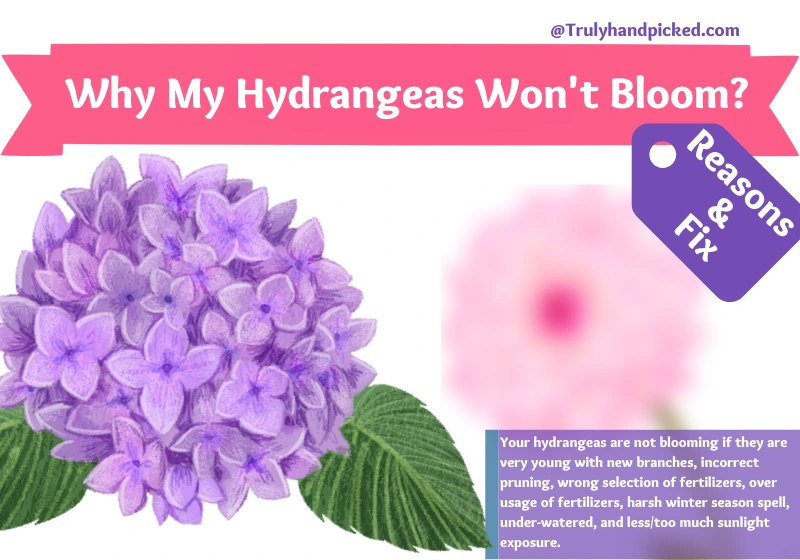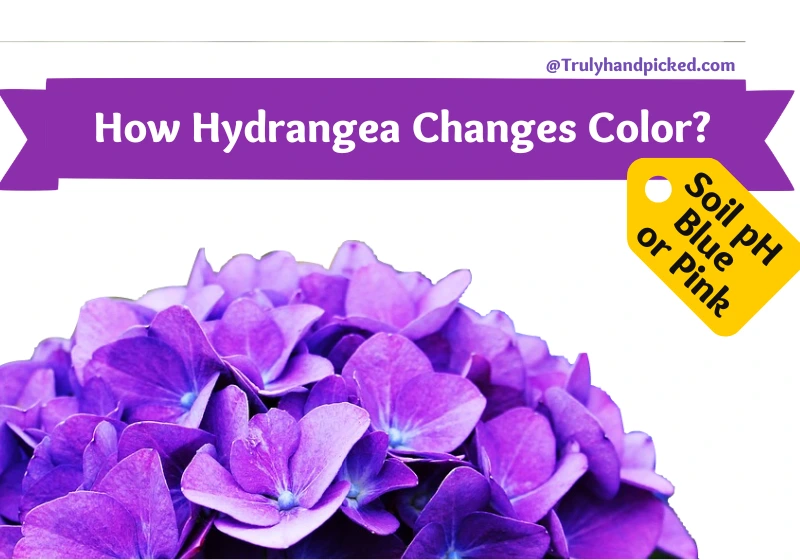Hydrangea is a flowering plant that produces a stunning view while fully blooming. Whether it grows in an outdoor orchard or a small indoor garden area, hydrangea eternally looks ravishing due to its vibrant blossoms.
This beautiful plant has almost 75 species in its single genera. This plant is very particular about its basic growing needs. But the entire beauty of this divining plant goes in vain when the plant suddenly stops blooming.
In short: Your hydrangeas are not blooming if they are very young with new branches, incorrect pruning, wrong selection of fertilizers, over usage of fertilizers, harsh winter season spell, under-watered, and less/too much sunlight exposure.
You have to provide the plant with fully fertile well-drained soil that must be rich in compost or organic fertilizer (less in nitrogen). You should keep your planter always under bright and indirect sunlight at a moderately warm temperature.
Let’s learn how to get a handful harvest from your hydrangea plant before the end of its blooming season-
Quick Overview: Why My Hydrangea Is Not Blooming?
No matter whether you cultivate some beautiful hydrangea plant indoors or outdoors, they sometimes face this unfortunate issue. Here are some probable reasons why your hydrangea is not blooming-
- Growing hydrangea in a restricted pot from the cutting of a garden-grown species may disappoint you for the blooming season
- Placing your hydrangea under direct or scorching sunlight for too long, it always seeks bright but indirect sunlight
- If you can’t provide your plant adequate growing climate, especially put it in improper hardiness zones,
- When you trim off or prune the growing shoots of a hydrangea plant unknowingly or prune them in a growing season instead of the proper time
- If you feeding your plant with high nitrogen or undiluted fertilizer
- When you fertilize your hydrangea plant during the wrong season like winter instead of spring or early summer
- If you can’t provide your plant with phosphorus-rich fertilizer feed that can boost the blooming quality of your plant
- When you plant your hydrangea in a low-acidic soil, as this plant always thrives best in soil with a high acidic pH level
- If you keep your plant thirsty for long with inadequate water supplies, hydrangea always wants evenly moist soil consistently
- When you expect your hydrangea plant to bloom from a newly planted species without giving it the proper time to thrive, a hydrangea plant needs a couple of years to reach the stage of blooming
- And when nature does the conspiracy by providing sudden frost or improper cold temperature in late spring
These all causes can stunt the flower buds or prevent your growing hydrangea plant from reaching its blooming period effectively.
Why Aren’t My Hydrangeas Blooming? Reason and Fix
There are always some constant mismanagement issues that work behind the not-blooming problem of a hydrangea plant. Different species of hydrangea requires different caring regimen. However, the basic needs always remain quite similar. Thus, no matter what type of hydrangea you are growing in your yard, they can go through the non-blooming problem most frequently, for the same reasons. Some common causes of this crisis are-
Sunlight Issue:
- When your plant couldn’t get enough morning sun
- If you keep your plant unshaded afternoon sunlight
- When you put your plant in a full shady place
Unexpected Spring Frost:
- If you keep your plant unprotected under extreme frost
- When you put your planter near cool open drafts
- If you don’t provide cover to your plant during sudden spring frost
Improper Climate:
- When you put your hydrangea plant in an unsuitable hardiness zone
- If you change the growing climate of your plant frequently
- When you don’t provide a consistent growing temperature to your plant
Long Uprunning Session:
- If you don’t give the new buds enough space to bloom by trimming the old ones
- When you don’t trim off the old woods in time
- And if you keep your plant congested by old or dead leaves for long
Unsuitable Fertilizer:
- When your plant suffers from nutrient deficiency by low-fertilization
- If you are feeding your plant with a high-nitrogen fertilizer for long
- When you don’t maintain the acidic pH level of the soil during the planation
Plantation Shock:
- If you repot your growing hydrangea often
- When you don’t give your plant enough time to establish after the plantation
- Or when you move or rotate your planter often after repotting
Insufficient Watering:
- When your plant suffers from a lack of moisture due to infrequent watering
- If you keep the soil dry for more than a week
- When you don’t follow a steady watering routine throughout its entire growing session
Solutions:
Try these simple yet effective hacks to get rid of the crisis of not-blooming your hydrangea plant shortly-
Water Sufficiently:
- Never give your plant drought stress by keeping it underwatered
- Water your growing hydrangea once the top 1-inch of the soil seems dry
Feed Adequately:
- Choose a fertilizer that is high in phosphorous and low in nitrogen
- Sow your hydrangea in highly acidic soil with a good pH level
Provide Proper Sunlight:
- Take your plant out in a spot where it can get bright sunlight for 4-5 hours a day
- Keep your plant dappled afternoon sun rays
Don’t Shake Often:
- Hydrangea plants need a couple of years to settle in a new growing medium
- So, stop repotting your plant frequently and give it time to relax after a repotting session
Prune Immediately:
- Once you find the old leaves or buds or woods appear on your plant, cut them off instantly
- Follow a consistent pruning session once a month attentively
Check For The Suitable Climate:
- Keep your plant in a condition around 50°-60° F
- Make sure the humidity level maintains high and the hardiness zone stays between 3-7
Protect From The Frost:
- Keep your plant away from open windows or cold drafts
- And provide some protective layers with burlap, blankets, etc. to keep your hydrangea protected from sudden late spring frost.
How to Make My Hydrangea Blooming:
We mentioned above how to get rid of the crisis of not-blooming your hydrangea plant expertly. Now, why don’t we try some methods that never allow your plant to suffer from such issues ever in its whole growing session?
Well, precaution is always better than prevention. So, here we emerge with some effective caring tips for a hydrangea plant for you.
These simple yet efficient tips not only keep the blooming nature of your plant unaffected but also boost their natural blooming capacity potentially-
Water Regularly:
- Water your plant regularly, at least for the first few seasons
- Let the soil get moist deeply but not water-logged
- Never let the soil turn dry entirely
Provide Enough Light:
- Place the planter near an east or south-facing window
- Make sure your plant could get 4-5 hours of bright and direct light every day in the morning
- Increase and decrease the amount of water depending on the weather
Pick The Soil Mindfully:
- Pick a soil that is fully fertile and has well-drained quality
- Maintain the slightly acidic pH level and make the soil rich in humus
- To prepare a perfect mix, combine compost, sand, manure, peat moss, and lime in an equal amount
Use Perfect Fertilizer:
- Buy a commercial hydrangea fertilizer that is low in nitrogen for the best result
- You can also use homemade compost to feed regularly to feed your plant
- Keep the phosphorous level of the fertilizer high as it boosts the blooming capacity naturally
Maintain Proper Climate:
- Put your planter in a climate with high humidity and moderate warmness
- Maintain the growing temperature between 55° to 65° F
- And always keep your plant in a hardiness zone between 3 to 7
Prune Attentively:
- Prune any discolored or problematic leaf, stem, or buds immediately after detecting
- Use only sterilized pruner or shear to cut off plant parts
- Trim off extra leggy or unwanted healthy segments too and propagate them, if needed
Keep Protected From Pests and Diseases:
- Look for the common hydrangea insects like aphids, spider mites, beetles, weevils, etc.
- Treat them with effective homemade remedies like rubbing alcohol, neem oil spray, etc.
- Check out common diseases like botrytis blight, powdery mildew, yellow leaf spotting, etc. Try to Repot your plant immediately and apply natural fungicides on your plant to clear them off.
FAQ:
Can You Change The Color Of A Hydrangea Flower After Planting?
You can change the color of your hydrangea flower simply by changing the pH level of the soil. Soil with high acidic content produces blueish flowers, while high alkaline soil helps to grow pinkish flowers more.
What Type Of Climate Suits Best For A Growing Hydrangea Plant?
Most of the Hydrangea species thrive best in a spot with a cool, moist, bright yet shady climate. Try to maintain a perfect Hardiness zone along with a preferable atmosphere to get a handful of harvest at the end of your plantation.
How to Change Hydrangea Color?
The large globe-shaped flowers of hydrangea grow in several vibrant shades, which make this flowering plant so popular as a garden as well as a houseplant.
The color of hydrangea flowers mostly varies with its selected species. But, do you know that you can change some colors of your garden hydrangea plant only by changing a few simple things in its essential growing need list?
Well, this may sound crazy, but this fact is true!
Here are some smart tricks in this regard of how to change the colors of a growing hydrangea plant accordingly-
- Find out the exact soil pH level of your planted hydrangea plant
- Hydrangeas that cultivate in acidic soil can provide blue flowers
- On the other hand, soil with high alkaline pH produces pink or red hydrangea flowers
- So, if you want to turn your pinkish blossoms into blueish ones, keep the soil pH level less than 5.5
- And if you like to turn the blue ones into the pinkish species, keep the pH level greater than 6.0
- You can’t change the color of white hydrangea flowers with soil quality; however, they prefer alkaline type soil like the red or pink ones
- And you must give your garden hydrangea plants more than one or two months to let them change their shade gradually
To change the soil pH level
- Deicide you should turn the pH level higher or lower first
- Now, add some limestone in granulated form with a ratio of 4 pounds/1 square feet area to raise the alkaline level
- To raise the acidic level, apply the aluminum sulfate in diluted form with a ratio of ¼ ounces in 1 gallon of water
- Try to apply limestones two times a year during spring or fall. On the other hand, sprinkle aluminum sulfate three times a year during early spring with 2-3 weeks of intervals
- To increase the acidity of the soil, apply a suitable fertilizer with a ratio of 25-5-30 NPK ratio
- While the perfect amount for alkaline soil is a 25-10-10 NPK ratio
Besides, changing the soil pH level, these conditions can change the color of your chosen hydrangea flower naturally sometimes-
- Always use distilled water to water your plants
- Water with high-mineral content also can affect the shade of a growing hydrangea plant
- And wait till the plant reaches its final stage of growth. As the color gets faded due to its natural aging process.


